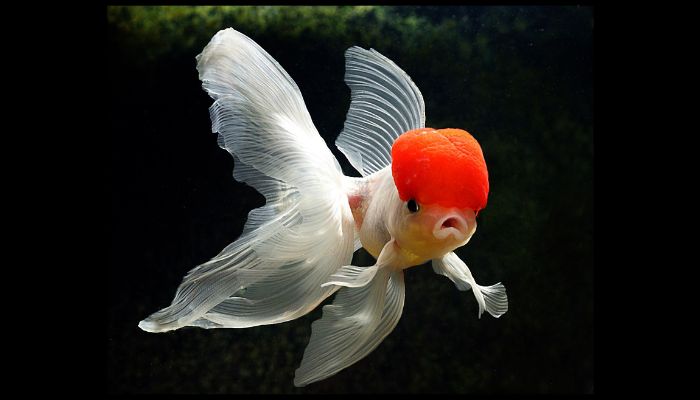Getting into the world of fishkeeping can be an exciting and rewarding hobby. But if you’re new to the hobby, you might be wondering, what is the best fish for beginners? Not all fish are easy to care for, so it’s important to choose species that are hardy, low-maintenance, and thrive in beginner-friendly conditions. In this article, I’ll provide a complete list of the best fish for beginners and share tips to help you start your fishkeeping journey with confidence. Whether you’re setting up a small tank or planning for a larger aquarium, this guide will help you make the right choices from the start!
What to Look for in Beginner-Friendly Fish
Before diving into the list, it’s important to know what makes a fish a good fit for beginners. Here are a few factors to consider:
- Hardiness: Beginner fish should be able to handle minor fluctuations in water quality. They should be tough enough to tolerate occasional mistakes in feeding or tank conditions.
- Low Maintenance: As a new fish keeper, you don’t want fish that require constant attention or special care. Look for fish that are happy with simple, consistent care.
- Community Compatibility: If you plan to have more than one type of fish, they should get along with others and be peaceful in nature.
- Size Matters: Smaller fish are generally easier to care for since they need less space and produce less waste.
With that in mind, let’s get into the complete list of the best fish for beginners. These species are popular for their resilience, ease of care, and ability to thrive in a variety of environments.
1. Betta Fish (Betta splendens)
When you ask, What is the best fish for beginners?, one of the first names that comes to mind is the Betta fish. Known for their vibrant colors and flowing fins, Bettas are an excellent choice for new fish keepers.
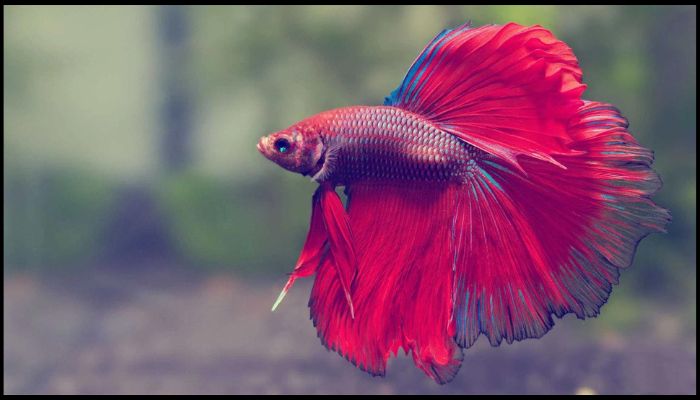
Why They’re Great for Beginners:
- Low Maintenance: Bettas are hardy and don’t require a huge tank. They can live happily in small aquariums, although a 5-gallon tank is recommended for optimal health.
- No Filter Needed: Bettas don’t need strong water filtration, as they can breathe from the surface, thanks to their labyrinth organ.
- Solo Stars: Bettas are best kept alone, so if you don’t want the responsibility of managing tankmates, they’re a great pick.
However, keep in mind that Betta males are territorial and should not be housed with other male Bettas, or they’ll fight.
2. Neon Tetras (Paracheirodon innesi)
If you’re looking for a small, colorful fish that does well in groups, Neon Tetras are an excellent choice. These peaceful fish are known for their electric blue and red stripes, which make them stand out in any aquarium.

Why They’re Great for Beginners:
- Hardy and Resilient: Neon Tetras are forgiving of minor changes in water conditions, making them ideal for a beginner’s tank.
- Schooling Fish: These fish love to swim in groups, so keeping a small school (6 or more) will make them feel safe and happy.
- Low Maintenance: They don’t require a large tank or any special care, making them a go-to for beginner aquarists.
Neon Tetras are peaceful and do well with other non-aggressive fish, which means they can be part of a friendly community tank.
3. Guppies (Poecilia reticulata)
Guppies are another beginner-friendly species, famous for their bright colors and lively personalities. They’re easy to care for and breed, making them one of the best fish for beginners.
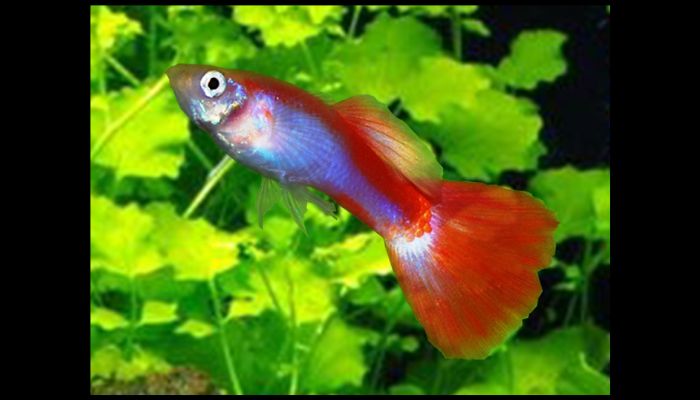
Why They’re Great for Beginners:
- Very Hardy: Guppies can adapt to a wide range of water conditions and are generally low-maintenance.
- Active and Fun to Watch: They are lively swimmers and will add a lot of movement to your tank.
- Easy to Breed: If you want to try your hand at breeding fish, guppies reproduce easily—sometimes too easily! Make sure you’re prepared for guppy fry (baby fish).
Guppies are best kept in groups and come in a wide range of colors, which makes them visually appealing in any tank.
4. Zebra Danios (Danio rerio)
Zebra Danios are small, striped fish that are famous for their durability. These guys are often the go-to choice for beginner fishkeepers because they’re nearly indestructible.
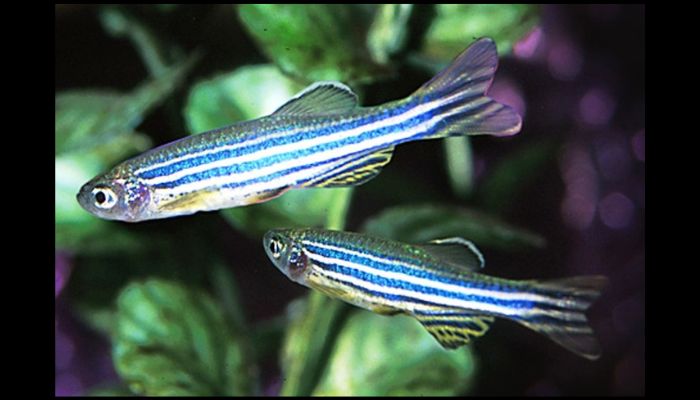
Why They’re Great for Beginners:
- Super Hardy: Zebra Danios can tolerate a variety of water conditions and are very forgiving of minor mistakes.
- Great in Schools: Like Neon Tetras, they love being in groups and will thrive when kept in a school of 5 or more.
- Low-Maintenance: They don’t require a special tank setup and are peaceful community fish.
Zebra Danios are also very active and entertaining to watch as they dart around the tank.
5. Corydoras Catfish (Corydoras spp.)
If you’re looking for a bottom-dwelling fish that helps keep your tank clean, look no further than Corydoras Catfish. These gentle fish spend most of their time scavenging for food on the bottom of the tank.
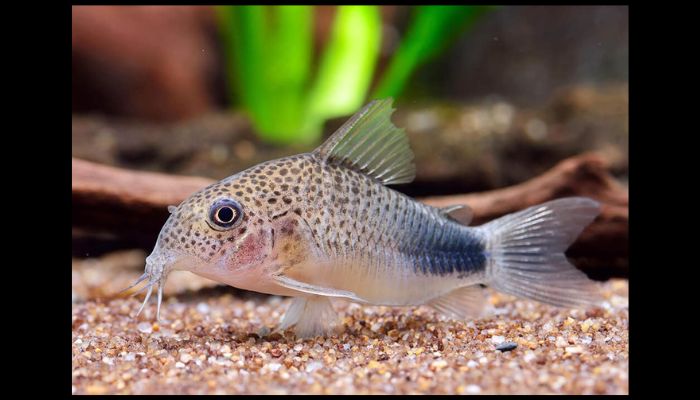
Why They’re Great for Beginners:
- Easygoing: Corydoras are peaceful and get along with almost any fish.
- Tank Cleaners: They’ll help keep your tank tidy by eating leftover food that sinks to the bottom.
- Hardy: These fish can adapt to a variety of water conditions and are easy to care for.
Corydoras are social and should be kept in groups of at least three. Their peaceful nature makes them great companions in community tanks.
6. Mollies (Poecilia sphenops)
Mollies are livebearers like guppies, meaning they give birth to live young instead of laying eggs. They come in many different colors and varieties, making them a popular choice for beginner aquarists.
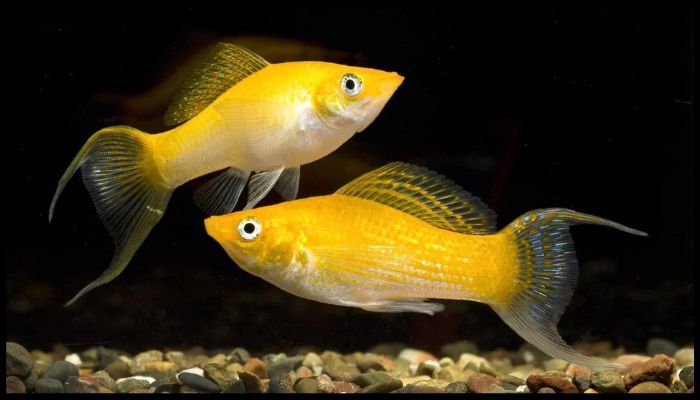
Why They’re Great for Beginners:
- Adaptable: Mollies are hardy fish that can live in a wide range of water conditions, including both fresh and slightly brackish water.
- Low-Maintenance: They don’t require any special care and are relatively easy to feed.
- Fun to Breed: If you’re interested in breeding fish, mollies reproduce easily in captivity.
Mollies are social fish and do best when kept in groups. Just make sure you have enough space in your tank if you’re not ready to handle the baby fish!
7. Platies (Xiphophorus maculatus)
Another livebearer, Platies, are colorful, peaceful fish that do well in a beginner’s tank. They’re small, hardy, and come in a variety of color patterns, making them a joy to watch.

Why They’re Great for Beginners:
- Hardy: Platies are resilient and can tolerate a range of water conditions.
- Low Maintenance: They don’t need a large tank or any special care.
- Peaceful: Platies are known for their peaceful temperament and can live harmoniously with other community fish.
If you want a fish that’s low-maintenance and adds color to your tank, Platies are a solid choice.
8. Swordtails (Xiphophorus hellerii)
Swordtails are similar to Platies and Guppies but are distinguished by the long, sword-like extension on the males’ tails. They’re easy to care for and breed, making them a great choice for beginners.
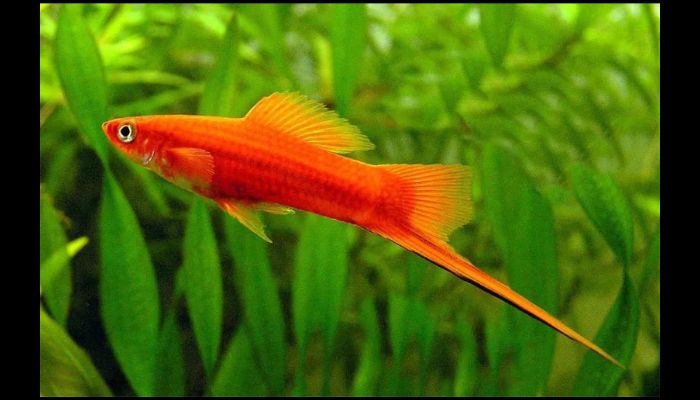
Why They’re Great for Beginners:
- Hardy: Swordtails can adapt to different water conditions and are relatively easy to care for.
- Active Swimmers: They’re lively and fun to watch as they swim around the tank.
- Easy Breeders: Like guppies and mollies, swordtails are livebearers and will easily breed in captivity.
Swordtails are peaceful but do best with tank mates that are also non-aggressive.
9. Goldfish (Carassius auratus)
Goldfish are one of the most popular fish for beginners, but they do require more space than people often think. While they’re easy to care for, they need a proper-sized tank and regular maintenance to stay healthy.

Why They’re Great for Beginners:
- Hardy: Goldfish are robust and can live in a variety of water conditions.
- Long Lifespan: With proper care, goldfish can live for many years, sometimes even decades.
- Easy to Feed: They’ll eat just about any type of fish food, making feeding time a breeze.
Just make sure to avoid the common mistake of keeping goldfish in bowls. They need ample swimming space, so a 20-gallon tank is recommended for one goldfish.
10. Cherry Barbs (Puntius titteya)
Cherry Barbs are small, peaceful fish with striking red coloration. They’re easy to care for and do well in small groups.
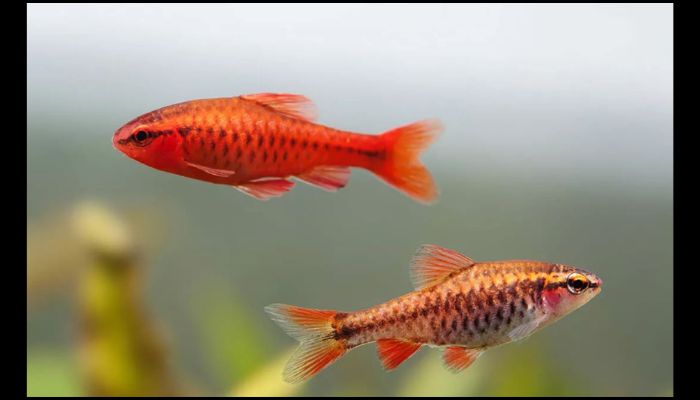
Why They’re Great for Beginners:
- Low Maintenance: Cherry Barbs are hardy fish that can thrive in a range of water conditions.
- Peaceful: They’re great community fish and can be kept with other non-aggressive species.
- Colorful: Their bright red coloring adds a pop of color to your aquarium.
Cherry Barbs are schooling fish, so it’s best to keep them in groups of at least five for optimal health and happiness.
Final Thoughts on What is the Best Fish for Beginners? Complete List
Choosing the right fish is crucial for a successful and enjoyable fishkeeping experience. While many species are beginner-friendly, you should always research the specific needs of any fish you’re considering to ensure they fit your tank setup and lifestyle. In summary, when asked, What is the best fish for beginners?, the complete list of species above offers plenty of great options, whether you’re looking for vibrant colors, hardy swimmers, or low-maintenance tankmates.
Start with fish that are hardy, peaceful, and low-maintenance, and you’ll find that fishkeeping is an incredibly rewarding hobby. Don’t forget to cycle your tank before introducing any fish, maintain proper water conditions, and enjoy the relaxing beauty of your new aquatic friends!
FAQs: What is the Best Fish for Beginners? Complete List
1. What is the best fish for beginners?
The best fish for beginners are those that are hardy, low-maintenance, and peaceful. Some top picks include bettas, guppies, tetras, mollies, and zebra danios. These species can handle common beginner mistakes like fluctuating water conditions and are easy to care for.
2. Can beginners keep saltwater fish?
Ah, the allure of a stunning saltwater aquarium is real! But for beginners, starting with freshwater fish is typically a safer bet. Saltwater fish can be a bit finicky, requiring more precise water parameters and care. Once you’ve mastered freshwater fish, then you can level up to the saltwater game.
3. Do I need a huge tank for my first fish?
Nope! While a bigger tank can be more stable, a small 10-gallon tank is a great starting point. However, avoid those teeny-tiny tanks (like the size of a coffee mug). Fish deserve space to stretch those fins!
4. How many fish should I start with?
Let’s not go full Finding Nemo on your first go! Start with a small number of fish—say, 3-5 for a 10-gallon tank. You can always add more once you’re confident with their care and tank maintenance.
5. Can I mix different species together?
Absolutely, as long as the fish are compatible! Some species are social and get along swimmingly with others (pun intended). Just do a little research to ensure that your fish won’t end up at odds with each other. Bettas, for example, prefer solitude, while tetras are happiest in groups.
6. How often should I feed my fish?
You don’t want to overfeed your fish, or you’ll have a tank that looks like a fast-food disaster! Twice a day with small amounts is usually ideal. A good rule of thumb: feed them what they can eat in 2-3 minutes, and remove any leftovers. You know, like cleaning up after a snack attack.
7. Do I need a filter for my fish tank?
Yes, definitely! A filter helps keep the water clean, oxygenated, and free from harmful toxins. Think of it as your fish’s life support system. Plus, it’ll save you a ton of cleaning headaches.
8. How often should I clean my fish tank?
Once a week is a good routine for water changes and cleaning. No need for a full tank scrub every time, just about 25% of the water. Trust me, your fish will appreciate the fresh environment, and you’ll avoid the dreaded “cloudy tank syndrome.”
9. Can goldfish live in a bowl?
Ah, the classic goldfish bowl myth. Spoiler alert: They need way more space than that tiny bowl. Goldfish can grow pretty large and need a proper tank with a filter. A 20-gallon tank is ideal for one goldfish. Sorry, but no more goldfish-in-a-bowl scenarios, folks!
10. What is the easiest fish to take care of?
Guppies, bettas, and zebra danios take the crown for being the easiest. These fish are low-maintenance, tolerate less-than-perfect conditions, and don’t require a PhD in fishkeeping to keep happy. They’re practically bulletproof (but, you know, don’t test that).
11. Do fish get lonely?
It depends on the species! Schooling fish like tetras and guppies enjoy the company of their kind. Bettas, on the other hand, prefer solo living. So, before you start matchmaking your fish, check their social preferences.
12. Should I use live plants in my fish tank?
Live plants can be a fantastic addition! Not only do they look great, but they also help keep the water clean by absorbing excess nutrients. Just make sure you choose easy-to-care-for plants like java ferns or anubias—perfect for beginners.
13. Can fish recognize their owners?
Believe it or not, yes! Fish can recognize the person who feeds them and may even swim up to greet you at feeding time. It’s not quite dog-level loyalty, but hey, we’ll take it!
14. How long do beginner fish live?
With proper care, beginner fish like guppies, tetras, and bettas can live anywhere from 2-5 years, sometimes even longer. It all depends on their environment and how well you follow through with their care. So, be a good fish parent, and your finned friends will stick around for quite a while!
15. What’s the most important thing to remember as a beginner fishkeeper?
Patience! Don’t rush the process, and make sure you’ve set up your tank correctly before adding fish. Cycling your tank (letting beneficial bacteria establish) is crucial for maintaining a healthy environment. Once you get that down, your fishkeeping journey will be a breeze!
